Wattles for the garden and back yard
Wattles for the garden
The history of cultivation of wattles goes back to the middle of the eighteenth century, perhaps even further than that. The first evidence that an Australian wattle was cultivated comes from a book published in 1768 and it refers to a specimen that was grown in a private botanical garden in Batavia (now Jakarta) from seed that must have been collected in Australia, possibly by the Dutch explorer Vlamingh. He visited Swan River district (now Perth, Western Australia) in 1697 and most likely took some seeds (doubtfully plants) to Java.
Australian wattles were introduced into England soon after British settlement at Port Jackson (New South Wales) and immediately proved very popular. With the passing of time many different species were introduced not only to England but also to many European countries.
Many wattles are excellent plants for the garden and a selection appears below covering a wide range of regions and conditions in Australia. A trip to your local plant nursery for advice on specific species would always be worthwhile for additional help. It is possible, also, to choose a wattle that should flower on 1 September in your area.
The following wattles are listed in order from the smallest (2m) to the largest (30 m) by height
(a useful characteristic for selecting a wattle for your garden or property):
Acacia aspera (Rough Wattle)
Native to New South Wales and Victoria
Small spreading shrub 2 m high. Phyllodes 1-4 cm long and 1-4 mm wide, covered with rigid hairs. Flowers bright yellow, appearing from Jul-Nov. Moderately frost hardy. Suitable for planting in most parts of southern Australia and useful for small gardens.
Acacia drummondii (Drummond’s Wattle). Native to Western Australia. Rounded or erect shrub up to 2 m high. Leaves bipinnate. Flowers in spikes up 1.5-3.0 cm long, bright golden yellow, appearing Jul-Oct. Moderately frost hardy. Suitable as a garden shrub for temperate regions.
Acacia gracilifolia (Graceful Wattle). Native to South Australia where it is confined to the southern Flinders Ranges.
Usually a spreading shrub 1-2 m high. Phyllodes long and narrow, about 5-15 cm long and 1-2 mm wide. Flowers in globular heads, bright golden-yellow, appearing Aug-Oct. Not expected to be frost hardy. An excellent garden subject on account of its graceful habit and superb flowers. Suited to most parts south-eastern Australia.
Acacia acinacea (Gold-dust Wattle)
Native to South Australia, New South Wales and Victoria.
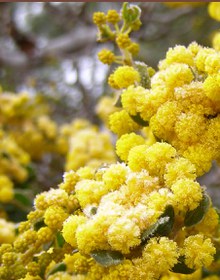
Gold-dust Wattle (Acacia acinacea) dusted with frost
Photo: ©S.D. Searle
Small spreading shrub 1-2.5 m high. Phyllodes narrow or round, 1-3 cm long and 0.5-1.0 cm wide. Flowers in small globular heads; usually deep yellow. Masses of flowers in spring. Moderately frost hardy. Suitable for small gardens in south-eastern Australia.
Acacia argyraea (no common name). Native to Western Australia, Northern Territory and Queensland.
Tree 3 m high or a shrub with blue-grey foliage. Phyllodes 4-8 cm long and 1.5-4.0 cm wide, densely covered with silvery hairs. Flowers in spikes 1.5-3.0 cm long, yellow, appearing Apr-Jul. Suitable for small gardens in northern Australia. Not frost hardy. Suitable for planting in tropical and subtropical regions.
Acacia rossei (Rosse’s Wattle). Native to Western Australia.
Open shrub 2-3 (-5) m high. Phyllodes linear, 1-2 cm long and less than 1 mm wide, usually sticky, densely arranged towards the ends of the branches. Flowers in globular heads on long stalks grouped towards the ends of the branches, deep golden-yellow, appearing Jul-Nov. Should survive very mild frosts. Spectacular shrub suitable for dry sandy areas in temperate Australia.
Acacia cardiophylla (Wyalong Wattle)
Native to New South Wales.
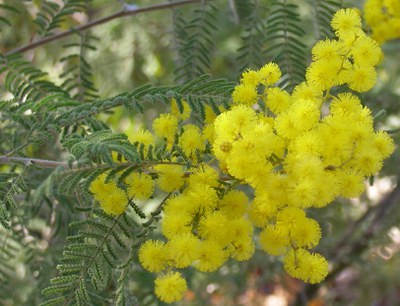
Acacia cardiophylla
Photo: ©S.D. Searle
Small spreading tree to 3.3 m high. Leaves bipinnate, often yellow-green. Flowers in globular heads, bright golden-yellow, appearing Oct-Dec. Moderately frost hardy. Suitable for small gardens in most parts of south-eastern Australia.
Acacia boormanii (Snowy River Wattle)
Native to New South Wales and Victoria.
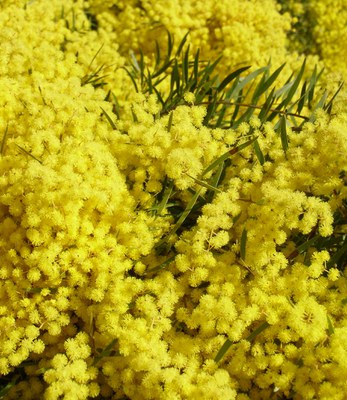
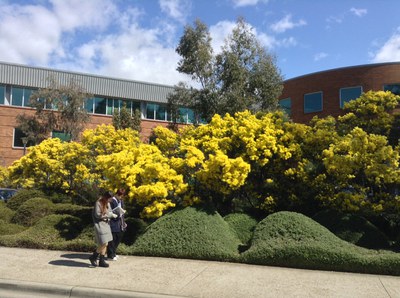
Snowy River Wattle forms a golden hedge at the ANU
Photo: ©S.D. Searle
Erect tree 4 m high or usually a shrub. Phyllodes linear, 2-8 cm long and 1.5-3.0 mm wide, pale bluish-grey. Flowers in small globular heads, bright yellow, appearing Aug-Oct. Moderately frost hardy. This species has a tendency to become an adventive in bushland in some areas and it also suckers readily.
Acacia buxifolia (Box-leaved Wattle)
Native to Queensland, New South Wales, Australian Capital Territory and Victoria.
Shrub 1-4 m high, rather straggly but it flowers very well in spring. Phyllodes small and oblong, usually 1.5-3.0 cm long and 0.8-1.5 cm long. Flowers in small globular heads, usually deep golden-yellow, appearing Jul-Nov. Moderately frost hardy. This wattle makes a very good display when many plants are grown closely together and is suitable for most parts of south-eastern Australia.
Acacia iteaphylla (Winter Wattle, Gawler Ranges Wattle)
Native to South Australia.
Erect or spreading tree 2-4 m high or a shrub. Phyllodes usually linear, 5-10 and 3-6 mm wide. Flowers in small short spike-like groups of 6-12 globular heads, creamy yellow, appearing principally Mar-Oct. Moderately frost hardy. Suitable for temperate regions.
Acacia spectabilis (Mudgee Wattle or Glory Wattle)
Native to Queensland and New South Wales.
Shrub or small tree up to 2-4 (-6 m) m high with bluish-grey stems and leaves. Leaves bipinnate. Flowers in large globular heads, bright golden yellow, appearing Jul-Oct. Moderately frost hardy. The brilliant flowers make it a superb garden specimen in most parts of temperate Australia especially when planted en masse.
Acacia vestita (Hairy Wattle)
Native to New South Wales.
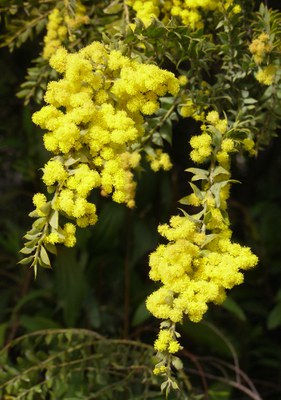
Photo: ©S.D. Searle
Spreading shrub up to 4 m high. Phyllodes usually ovate or elliptical, 1-2 cm long, densely hairy. Flowers in globular heads, golden yellow, appearing Sep-Oct. Moderately frost hardy. Popular garden shrub suitable for temperate regions.
Acacia kempeana (Witchetty Bush)
Native to Western Australia, Northern Territory, South Australia and Queensland.
Spreading shrub 2-5 m high. Phyllodes narrow-elliptic, 5-10 cm and 0.5-1.5 cm wide, bluish-green. Flowers in spikes 2.5-5.0 cm long, mid-yellow, appearing Jun-Aug. Suitable for dry regions where frosts are absent.
Acacia macradenia (Zig-zag Wattle)
Native to Queensland.
Shrub up to 3-5 m high with zig-zag stems. Phyllodes narrow-lanceolate, 15-25 cm long and 2-3 cm wide. Flowers in globular heads, golden yellow, appearing Jul-Aug. Not expected to tolerate frosts. Suitable for subtropical regions.
Acacia adunca (Wallangarra Wattle or Cascade Wattle)
Native to Queensland and New South Wales.
Broom-like tree up to 6 m high. Phyllodes long and narrow, 5-12 cm long and 1-4 mm wide. Flowers in globular heads, deep golden yellow, appearing Apr-Nov. It is one of the most brilliant of the wattles renowned for flowers and young coppery foliage. Moderately frost hardy. Suitable for planting in the tablelands districts of New South Wales.
Acacia dunnii (Elephant Ear Wattle) Native to Western Australia and Northern Territory.
Open shrub or small tree up to 6 m high, rarely higher. Phyllodes are the largest of all Acacias and are up to 45 cm long and 30 wide, hence the common name. Flowers in globular heads. Not expected to withstand frosts. Suitable for planting in tropical and subtropical regions and noted for its novelty value.
Acacia podalyriifolia (Queensland Silver Wattle, Mount Morgan Wattle)
Native to Queensland and New South Wales.
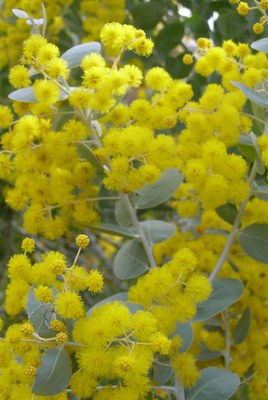
Photo: ©S.D. Searle
Spreading tree up to 7 m high. Phyllodes usually ovate, 2-4 cm long and 1.5-3 cm wide, densely hairy and silvery-grey. Flowers in globular heads, bright golden yellow, appearing Jul-Oct. Moderately frost hardy. Useful as garden specimen in temperate regions but it sometimes becomes invasive.
Acacia conspersa (no common name) Native to Northern Territory.
Tree up to 7.5 m high but often a shrub. Phyllodes narrow-lanceolate, 4-10 cm long and 0.5-1.0 cm wide, often crowded. Flowers in spikes up to 5 cm long, bright golden-yellow, appearing Apr-Jul. Not expected to be frost hardy. Suitable for planting in tropical and subtropical regions.
Acacia covenyi (Blue Bush or Coveny’s Wattle)
Native to New South Wales. Indigenous to the escarpment country near the Bendethra Caves between Cooma and Batemans Bay.
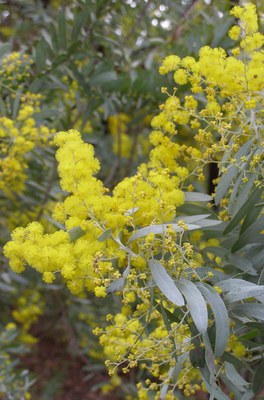
Shrub or small tree to 7.5 m high. Phyllodes lanceolate, linear or narrow lanceolate, 3-6 cm long and 0.5-1.0 cm wide, bluish-grey. Flowers in globular heads, golden yellow, appearing Aug-Sep. Moderately frost hardy. Although a relative newcomer to cultivation, it is proving popular and is suitable for most parts of south-eastern Australia.
Acacia aneura (Common Mulga)
Native to Western Australia, Northern Australia, South Australia, Queensland and New South Wales.
Erect or spreading tree up to 8 m high but can reach 18 depending on subspecies. Phyllodes variable in shape but usually lanceolate to linear, 2-10 cm long and 1-10 mm wide, greyish-green. Flowers in spikes 2-3 cm long, golden yellow, appearing mainly Jun-Sep. Moderately frost hardy. An important wattle in arid Australia where it is suitable for streets, gardens and parks. Common Mulga is highly prized for its hard colourful wood and has been used extensively for ornaments.
Acacia floribunda (Gossamer Wattle)
Native to Queensland, New South Wales and Victoria.
Spreading tree up to 8 m high. Phyllodes linear, 5-12 cm long and 2-10 mm wide. Flowers in spikes 3-5 cm long, creamy yellow, appearing Jul-Sep. Moderately frost hardy. Fast-growing tree useful as a screening plant and suitable for temperate regions. It grows well along creeks and rivers.
Acacia holosericea (Silky Wattle)
Native to Western Australia, Northern Territory and Queensland.
Erect or spreading tree up to 8 m high. Phyllodes mostly lanceolate, 7-10 cm long and 1-3 cm wide, greyish-green. Flowers in spikes 3-8 cm long, golden yellow, appearing Jun-Aug. Not expected to be frost hardy. A widely cultivated species in northern Australia and suitable for tropical and subtropical regions. Useful for shelter and soil erosion control.
Acacia papyrocarpa (Western Myall)
Native to Western Australia and South Australia.
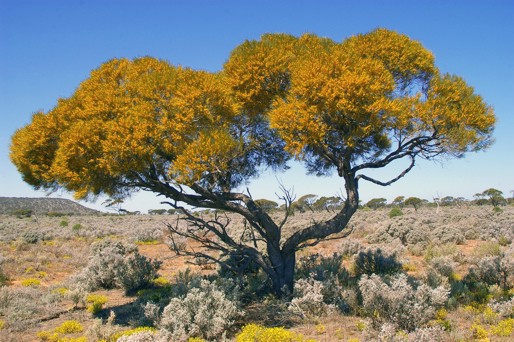
Acacia papyrocarpa Photo: Tony Robinson
Spreading tree up to 8 m high (rarely higher). Phyllodes linear, long and narrow, 4.0-8.0 cm long and 1-4 mm wide. Flowers in small globular heads, pale golden-yellow, appearing usually Aug-Oct but sometimes during other months. Can tolerate mild frosts. Hardy and long-lived and well-suited to sandy hard soils in southern Australia between eastern Western Australia and far western Victoria.
Acacia pravissima (Ovens Wattle)
Native to New South Wales, Australian Capital Territory and Victoria.
Spreading tree up to 8 m high. Phyllodes more or less triangular, about 1.0-1.5 cm long and about the same wide, usually dull green. Flowers in small globular heads, yellow, appearing Aug-Oct. Moderately frost hardy. Useful for gardens and as shelter.
Acacia pycnantha (Golden Wattle)
Native to South Australia, New South Wales, Australian Capital Territory and Victoria, and has been introduced to the Perth District, Western Australia.
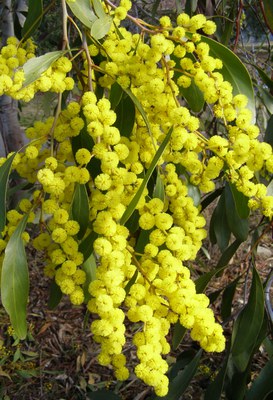
Photo: ©S.D. Searle
Small spreading tree to 3-8 m under good conditions. Phyllodes variable in shape ranging from obovate and oblanceolate to narrow lanceolate and sometimes falcate, 6-20 cm long and 1-5 cm wide, occasionally wider. Flowers in large globular heads, bright golden-yellow, appearing Jul-Oct. Moderately frost hardy. As Australia’s National Floral Emblem, this wattle is always worthy of planting and does well in temperate regions where severe frosts are absent. A local “strain” of the Golden Wattle in the Canberra region will survive very cold winters but the usual form from South Australia and Victoria might not unless it is well protected.
Acacia howittii (Sticky Wattle)
Native to Victoria where it is known principally from South Gippsland.
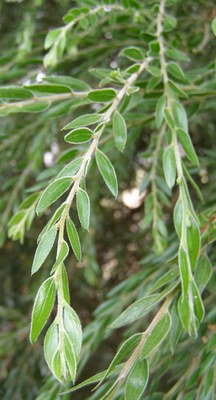
Photo: ©S.D. Searle
Tree up to 3-9 m high with bright green foliage often looking as though it has been varnished. Phyllodes 1.5-3 cm long and 0.5-10 cm long. Flowers in globular heads, usually creamy-yellow, appearing Aug-Nov. Moderately frost hardy. This is a very popular species because of its weeping foliage and is a good screen plant or can be clipped into a fine hedge. Suitable for temperate regions.
